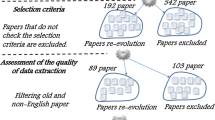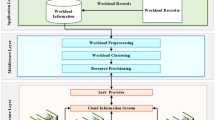Abstract
The small-world phenomenon is a principle in which seemingly distant nodes are linked by short chains of acquaintances. This property is found in a wide range of biological, social or natural networks. We proposed a self-adaptive model for solving the grid computing resources selection problem. A heuristic based on small-world concepts is defined within this model. Grid computing infrastructures are distributed systems with heterogeneous and geographically distributed resources. The present approach selects the most efficient resources during the application execution for facing the environmental changes. The model is tested in a real European grid computing infrastructure. Finally, from the results that have been obtained during the evaluation phase it is possible to conclude that the model achieves a reduction in applications execution time as well as an increase in the successfully completed tasks rate.








Similar content being viewed by others
Notes
Within the model, every task whose grid status is Done or Aborted is considered a finished task. Also tasks whose lifetime ends before they had finished are considered as finished tasks.
The workload value of a resource is calculated considering the local load (derived from other applications running in the infrastructure) and the load produced by our experiments.
As the model uses normalized values, this threshold is fixed at 1. That means, a resource is considered as overloaded when its capacity is being used at 100 %. Also, the workload value of every resource is normalized to determine if it exceeds the threshold.
All this information is collected from http://ibergrid.lip.pt/.
http://glite.cernch/.
References
Foster I (2002) What is the grid? A three point checklist. GRIDtoday 1(6):22–25
Foster I, Kesselman C, Tuecke S (2001) The anatomy of the grid. Enabling scalable virtual organizations. In: Keane JA, Gurd JR, Freeman L (eds) LNCS, Euro-Par 2001, vol 2150/2001. Springer, Heidelberg, pp 1–4
Erdos P, Rény A (1960) On the evolution of random graphs. Publ Math Inst Hung Acad Sci 5:17–61
Kleinberg J (2000) The small world phenomenon: an algorithm perspective. In: Proceedings of the thirty-second annual ACM symposium on Theory of Computing, Portland, OR, USA, 2000, pp 163–170
Newman M, Barabási AL, Watts DJ (2006) The structure and dynamics of network. Princeton University Press, Princeton
Mladenovic N, Hansen P (1997) Variable neighbourhood search. Comput Oper Res 24(11):1097–1100
Hansen P, Mladenovic N (2001) Variable neighbourhood search: principles and applications. Eur J Oper Res 130(3):449–467
Hansen P, Mladenovic N (1999) An introduction to Variable Neighbourhood Search. In: Voss S et al. (eds) Metaheuristics: advances and trends in local search paradigms for optimization, Kluwer, 1999, pp 433–458
Beyer WA, Sellers PH, Waterman MS (1985) Stanislaw M. Ulam’s contributions to theoretical theory, Letters in Mathematical Physics, vol 10. D. Reidel Publishing Company, Dordrecht, pp 231–242
Barabási A-L, Réka A (1999) Emergence of scaling in random networks. Sci AAAS 286(5439):509–512
Santiago A, Benito RM (2008) An extended formalism for preferential attachment in heterogeneous complex networks, Europhysics Letters, EPLA, vol 82, Issue 5, 2008
Botón-Fernández M, Prieto Castrillo F, Vega-Rodríguez MA (2011) Self-adaptive deployment of parametric sweep applications through a complex networks perspective. Computational science and its applications, vol 6783/2011., LNCSSpringer, Berlin, pp 475–489. ISBN:978-3-642-21886-6
Botón-Fernández M, Prieto Castrillo F, Vega-Rodríguez MA (2012) Nature-inspired algorithms applied to an efficient and self-adaptive resources selection model for grid applications. Theory and practice of natural computing, vol 7505., LNCSSpringer, Berlin, pp 84–96. ISBN:978-3-642-33859-5
Wrzesinska G, Maasen J, Bal HE (2007) Self-adaptive applications on the Grid, 12th ACM SIGPLAN symposium on principles and practice of parallel programming. San Jose, California, USA, pp 121–129
Buisson J, Andre F, Pazat J-L (2007) Supporting adaptable applications in grid resource management systems, GRID ’07. In: Proceedings of the 8th IEEE/ACM international conference on grid computing, IEEE Computer Society Washington, DC, USA, ISBN: 978-1-4244-1559-5, 2007, pp 58–65
Groen D, Harfst S, Portegies Zwart S (2009) On the origin of grid species: the living application. LNCS 5544:205–212
Sanjay HA, Vadhiyar SS (2011) Strategies for rescheduling tightly-coupled parallel applications in multi-cluster grids. J Grid Comput 9(3):379–403
Murugavel SS, Vadhiyar SS, Nanjundiah RS (2011) Adaptive executions of multi-physics coupled applications on batch grids. J Grid Comput 9(4):455–478
Cameron D, Gholam A, Karpenko D, Konstantinov A (2011) Adaptive data management in the ARC grid middleware, J Phys:Conf Ser, vol 331, part 6: Grid and cloud Middleware, 2011
Vadhiyar SS, Dongarra JJ (2005) Self adaptivity in grid computing, Concurrency and computation: practice and experience, vol 17. John Wiley, Chichester, pp 235–257
Huedo E, Montero RS, Llorente IM (2004) A Framework for adaptive execution in grids, software-practice and experience, vol 34. John Wiley, New York, pp 631–651
Keung HNLC, Dyson JRD, Jarvis SA, Nudd GR (2004) Self-adaptive and self-optimising resource monitoring for dynamic grid environments, DEXA’04. In: Proceedings of the database and expert systems applications, 15th international workshop, IEEE Computer Society, Zaragoza, Spain, pp 689–693
Berman F, Wolski R, Casanova H, Cirne W, Dail H, Faerman M, Figueira S, Hayes J, Obertelli G, Schopf J, Shao G, Smallen S, Spring N, Su A, Zagorodnov D (2003) Adaptive Computing on the Grid Using AppLeS. IEEE Trans Parallel Distrib Syst 14(4):369–382
Batista DM, da Fonseca LS (2010) A survey of self-adaptive grids, IEEE communications magazine, vol 48. IEEE Press Piscataway, Piscataway, pp 94–100
Du H, Wu X, Zhuang J (2006) Small-world optimization algorithm for function optimization. In: Jiao L, et al. (eds) ICNC 2006, Part II, LNCS 4222, pp 264–273
Barabási A-L, Réka A (1999) Emergence of scaling in random networks. Science 286(5439):509–512
Mladenovic N, Hansen P (1997) Variable neighbourhood search, computer and operations research, vol 24. Elsevier, San Diego, pp 1097–1100
Gardner M (1970) Mathematical games: the fantastic combinations of John Conway’s new solitaire game “Life”. Sci Am 223(4):120–123
Yang XS, Yang YZL (2007) Cellular automata networks. In: Adamatzky A, Bull L, De Lacy Costello B, Stepney S, Teuscher C (eds) Proceedings of unconventional computing. Luniver Press, Mexico, pp 280–302
Acknowledgments
María Botón-Fernández is supported by the PhD research grant of the Spanish Ministry of Science and Innovation at the Research Centre for Energy, Environment and Technology (CIEMAT).
Author information
Authors and Affiliations
Corresponding author
Rights and permissions
About this article
Cite this article
Botón-Fernández, M., Prieto-Castrillo, F. & Vega-Rodríguez, M.A. A self-adaptive resources selection model through a small-world based heuristic. J Supercomput 68, 1441–1461 (2014). https://doi.org/10.1007/s11227-014-1100-6
Published:
Issue Date:
DOI: https://doi.org/10.1007/s11227-014-1100-6




